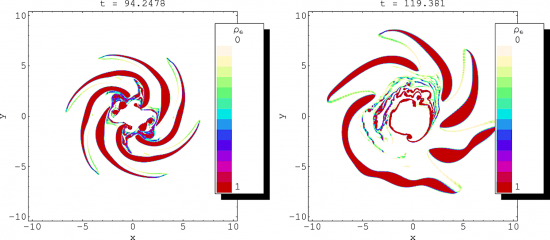
Non-linear evolution of the diocotron instability. Credit: J. Pétri, Observatoire Astronomique de Strasbourg
September 7, 2020
Editor’s note: The Picture of the Day will take a short recess today. Meanwhile, please enjoy this article from the archives.
Plasma does not obey the laws of kinetic energy.
“The plasma exhibited striations and double-layers, the electron distribution was non-Maxwellian, there were all sorts of oscillations and instabilities. In short, it was a field which was not at all suited for mathematically elegant theories.”
— Hannes Alfvén
Plasma instabilities are not well-known to the general public, or among astronomers. They refer to distortions that occur when plasmas are generated and confined. They are often confused with phenomena observed in fluid interactions: Kelvin-Helmholtz instabilities, or Rayleigh-Taylor instabilities, for instance.
Since plasmas are conventional matter with a small percentage of ionized particles, they do not conform to kinetic energy principles, alone. Rather, matter in the plasma state is strongly influenced by electromagnetism, and does not obey any other force, including gravity, except peripherally. Many types of instability are observed in plasma: diocotron instabilities, kink instabilities, edge instabilities (that make fusion reactors impossible to control), sausage instabilities (deformations in plasma flow), reactive instabilities, etc.
A principle tenet of Electric Universe theory is that various plasmas (mostly hydrogen ions and helium nuclei) comprise 99.99% of the Universe. Lightning, auroral curtains, the solar wind, the interstellar medium, stars, and galaxies; all are plasma-state matter. Since electromagnetism predominates, what is observed in space will manifest electric forces acting on charged material, no matter how tenuous.
Alessandro Giuseppe Antonio Anastasio Volta’s “voltaic pile”, one of the earliest batteries, opened Hans Christian Ørsted’s eyes in 1820. Ørsted identified the relationship between electricity and magnetism.
Volta’s apparatus was made up of alternately stacked discs that included copper, zinc, and cardboard impregnated with a salt solution. He attached conductive wires to the top and bottom of the stack. When the two wires were connected in a circuit, electric charge flowed through the battery pile. Ørsted reported that a compass needle was deflected whenever it came close to Volta’s battery. His observations led to André-Marie Ampère’s mathematical analysis of the “electromagnetic” effect.
Later, Dutch physicist Hendrik Lorentz, found that the velocity and charge of a particle, as well as magnetic field strength, influences the particle’s direction of travel. When electricity flows through a magnetic field, a force acts on the charges, producing torque. A force that is at right angles to both the direction in which a charged particle is moving, and the direction of the applied field, is called the “Lorentz force”.
Plasma’s behavior should be given first priority in any attempt to resolve natural phenomena. For example, hexagonal formations are observed in hurricanes, craters, Saturn’s polar hexagon, and galactic spirals. The astrophysical lexicon cannot explain bent, interlaced arms of what should be smooth spiral galaxies, nor can it adequately explain impact craters with straight sides and 120 degree vertices.
Most physicists have little training in electric theory, and no training at all in plasma theory. They have far too much to do without getting involved in topics that they consider irrelevant. Gravity is the foundation for scientific thought about the cosmos, so electrodynamic formulae are not consulted.
A diocotron instability explains the Saturnian hexagon quite well. Electric Universe theory also sees galactic structures to be the progeny of electromagnetic coupling. Birkeland current filaments conduct electricity across cosmic distances, twining around one another until they crush plasma into discrete formations. A typical barred spiral galaxy forms in two, or more, twists of those intergalactic filaments.
Diocotron instabilities in Birkeland current filaments are responsible for hexagonal shapes in galaxies and hurricanes—leading to a theory of electric weather. Since electric forces are trillions of times more powerful than gravity, when plasma is considered many mysteries are resolved.
Stephen Smith
The Thunderbolts Picture of the Day is generously supported by the Mainwaring Archive Foundation.












